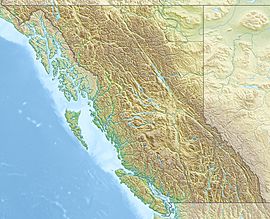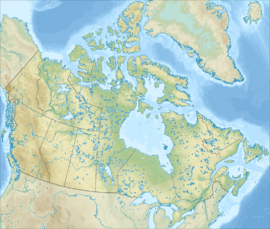Mount Pelops facts for kids
Quick facts for kids Mount Pelops |
|
|---|---|

Mount Pelops, east aspect
|
|
| Highest point | |
| Elevation | 2,015 m (6,611 ft) |
| Prominence | 105 m (344 ft) |
| Parent peak | Mount Niobe (2021 m) |
| Geography | |
| Location | Tantalus Provincial Park British Columbia, Canada |
| Parent range | Tantalus Range Coast Ranges |
| Topo map | NTS 92G/14 |
| Climbing | |
| First ascent | 1916 by J. Fyles and T. Fyles |
| Easiest route | Scrambling |
Mount Pelops is a mountain peak that stands 2,015 meters (6,611 feet) tall. It is located in the Tantalus Range within Tantalus Provincial Park in southwestern British Columbia, Canada. This park is a beautiful natural area.
The mountain is about 10 kilometers (6 miles) northwest of the town of Squamish. It is also about 7.5 kilometers (4.7 miles) southeast of Mount Tantalus, which is the highest peak in the Tantalus Range. Mount Pelops' closest taller neighbor is Mount Niobe, just 0.2 kilometers (0.12 miles) away to the northwest.
Rain and melting snow from Mount Pelops flow into streams that eventually join the Squamish River. The first time someone successfully climbed to the top of Mount Pelops was in 1916. This climb was made by two brothers, Tom Fyles and John Fyles.
The mountain gets its name from Pelops, a character in Greek mythology. He was the brother of Niobe and the son of Tantalus. Many peaks in the Tantalus Range are named after members of this mythological family. The name "Mount Pelops" was officially recognized on June 6, 1957, by the Geographical Names Board of Canada.
What is the Climate Like?
Mount Pelops is in a marine west coast climate zone. This means it has mild temperatures and a lot of rain, especially compared to other parts of North America. Most of the weather systems that affect the mountain come from the Pacific Ocean.
As these weather systems move east, they hit the Coast Mountains. The mountains force the air to rise, which cools it down. This process, called orographic lift, makes the air drop its moisture as rain or snow. Because of this, the Coast Mountains get a lot of precipitation, especially heavy snowfall in winter.
Winter temperatures on Mount Pelops can drop below −20 °C (–4 °F). With the wind, it can feel even colder, sometimes below −30 °C (–22 °F). Even with these cold temperatures, small parts of glaciers can still be found on the east and north sides of Mount Pelops. The best time to climb Mount Pelops is usually from July to September, when the weather is most favorable.
Climbing Mount Pelops
Mount Pelops offers several established routes for rock climbing. These routes are rated by how difficult they are.





